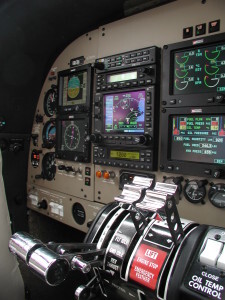By Stephen Quick
First published in Flight Levels Online, Fall 2013 issue

This issue we will discuss the Supplementary NTS Check Procedure as described by Honeywell Operating Information Letter OI331-20R1. While the Honeywell letter also addresses Feather Valve checks and Fuel Shutoff Valve checks, this article focuses on only the Supplementary NTS Check Procedure.
A complete NTS system functional check also includes the primary NTS check as specified in the aircraft manual. Although most Twin Commander pilots know about the primary NTS check, and readily demonstrate that knowledge in the simulator, many either do not know about the requirement for the Supplementary NTS Check Procedure or have never had it adequately explained to them.
I well remember, when I originally went to factory training on the 840 in Bethany, an instructor relaying the story of how he and another instructor went up to do an inflight NTS test on a customer’s 680V. The 680V has no NTS lights. A ground test can be done but the only way to really test whether the NTS system works is to shut down the engine and wait and watch. This they did. The description of the loss of control that followed was chilling.
My question to the instructor was, “So you do everything right and it still doesn’t work, what then?” The answer was less than satisfactory. The Supplementary NTS Check Procedure is the answer to that question so long ago.
A loss of power in a single-shaft turboprop engine can result in a high-drag condition if accompanied by a failure of the NTS system. In an attempt to maintain RPM through the propeller governor, the blades will drive towards a low-pitch condition resulting in an immediately critical airplane control issue.
The function of the NTS system is to relieve oil pressure in the propeller dome, allowing the propeller to move towards a high-pitch condition. This is accomplished when the torque sensor, sensing the propeller driving the engine during a loss of power, redirects oil flow to the feather valve, which reduces oil pressure in the prop dome. Without counter-opposing oil pressure in the dome, a feathering spring and counterweights drive the propeller to high pitch, thereby reducing drag.
The description of the check procedure, beginning on page 6 of the letter, is reproduced here:
SUPPLEMENTARY NTS CHECK PROCEDURE:
The NTS system ground check outlined in some aircraft manuals (utilizing the NTS Check or Beta light) verifies operation of the major NTS system components. However, the NTS system ground check does NOT completely verify the operational status of the NTS system. Specifically, the NTS system ground check does not verify whether the oil supply from the Propeller Governor (PG) is available to the NTS system because the check utilizes the propeller unfeather pump, instead of the PG, to supply oil pressure to the NTS system. If the oil passage between the PG and the downstream NTS system is blocked or restricted, the normal ground check procedure may not reveal the inoperative system. In this situation, the affected engine may not NTS in the event of an inflight shutdown, necessitating immediate manual feathering of the propeller to reduce windmilling drag.
One symptom of the loss of PG oil supply to the NTS system is resetting of the PG speed set point to a value 5 to 8 percent rpm above normal (for that Speed Control position) at power lever positions above flight idle. (Normally, the PG reset function increases the PG speed set point only when the power lever is brought below flight idle.) The supplemental NTS check procedure outlined below detects this symptom, which is indicative of a blockage potentially resulting in an inoperative NTS system.
It is strongly recommended that the supplemental NTS check procedure be accomplished prior to every flight:
- Perform normal engine start
- Propeller off the start locks
- Engine Speed Control set to LOW RPM
- Power Lever advanced above Flight Idle to extinguish the beta light (propeller governing mode)
- Propeller rpm should hold at the normal PG Low setting (93.5 to 96% rpm depending upon aircraft installation)
If propeller rpm increases above the normal PG Low setting, the NTS system may be inoperative and the flight should be postponed until the problem is resolved in accordance with the applicable aircraft or engine manuals, whichever is appropriate.
Caution:
Do not attempt to remedy the problem solely by adjusting the engine Speed Control level or propeller governor rigging. Adjusting the engine Speed Control lever or PG rigging to compensate for this anomaly is not the appropriate corrective action.
As you can see, this test is very important because of the possible consequences of a failure to NTS, especially when at low airspeeds near the ground. The pilot needs to be very sharp, both in recognition of the engine failure combined with a failure of the NTS and in piloting skills in order to maintain positive control of the aircraft.
Once again, let me emphasize that this check does not replace any existing checks that you do during your normal Before Takeoff checklist. This check, recommended by Honeywell, is in addition to the checks recommended by the aircraft manufacturer.
Steve Quick serves as a Twin Commander Instructor and King Air training program coordinator at SimCom’s training center in Dallas. He spent many years as a client of SimCom’s before joining the company in 2012 as a Twin Commander instructor. Steve comes from a family of aviators that goes back to the early years of aviation. He is experienced in the Shrike Commander, 681B, 690A, 690B, and 840, including aircraft that have been updated with Dash 10 engines and long-range slipper tanks.
